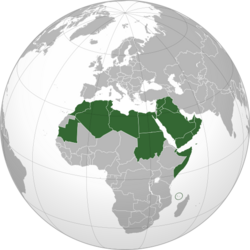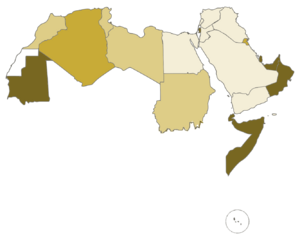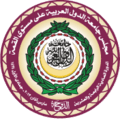Arab League facts for kids
Quick facts for kids
League of Arab States
|
|
|---|---|

Member states shown in dark green
|
|
| Headquarters | Cairo |
| Official languages | Arabic |
| Type | Regional organization |
| Members | |
| Leaders | |
|
• Secretary-General
|
Ahmed Aboul Gheit |
|
• Parliament Speaker
|
Ali Al-Daqbaashi |
| Legislature | Arab Parliament |
| Establishment | |
|
• Alexandria Protocol
|
22 March 1945 |
|
• Joint Defence and Economic Co-operation Treaty
|
18 June 1950 |
|
• Casablanca Protocol
|
11 September 1965 |
|
• Agreement for Judicial Cooperation
|
6 April 1983 |
|
• Greater Free Trade Area
|
2 January 2005 |
| Area | |
|
• Total area
|
13,132,327 km2 (5,070,420 sq mi) (2nd) |
| Population | |
|
• 2025 estimate
|
481,233,000 (3rd) |
|
• Density
|
36.64/km2 (94.9/sq mi) |
| GDP (PPP) | 2025 estimate |
|
• Total
|
$9.423 trillion |
|
• Per capita
|
$19,581 |
| GDP (nominal) | 2025 estimate |
|
• Total
|
$3.546 trillion (7th) |
|
• Per capita
|
$7,369 |
| Currency |
|
| Time zone | UTC+0 to +4 |
The Arab League, officially called the League of Arab States, is a group of countries in the Arab world. It was started in Cairo, Egypt, on March 22, 1945. Seven countries were the first members: Egypt, Iraq, Transjordan (now Jordan), Lebanon, Saudi Arabia, Syria, and North Yemen. Today, the Arab League has 22 member countries.
The main goal of the Arab League is to bring its member countries closer. They work together to protect their independence and discuss important issues. The organization helps with political, economic, and cultural projects. It also helps solve disagreements between member states.
Each member country gets one vote in the Arab League Council. Decisions are only binding for the countries that vote for them. In 1950, members also agreed to work together on military defense. In 2015, they decided to create a Joint Arab Force. This force helps fight extremism and other threats if a member country asks for help.
Contents
History of the Arab League
The Arab League was created on March 22, 1945. Its first main office was in Cairo, Egypt. The goal was to be a group of Arab countries working together. They wanted to improve their economies, solve problems, and coordinate their political goals. More countries joined later.
One of their first big actions was to try and prevent Palestine from being divided. The Arab League has tried to encourage cooperation among its members. However, it has faced challenges in achieving full unity. Leaders often want to keep their own country's power and independence.
Where the Arab League Is Located
The countries of the Arab League cover a huge area, over 13 million square kilometers. This area is spread across two continents: Africa and Asia. Much of it is made up of dry deserts, like the Sahara.
But there are also very fertile lands. These include the Nile Valley and the Fertile Crescent. The region also has deep forests in southern Arabia. The world's longest river, the Nile, flows through some of these countries.
Who Are the Members?
The Arab League's founding document, called the Charter, says that independent Arab states can join. In 1945, there were seven members. Now, there are 22 member countries. Eight of these are in Africa.
There are also 7 observer states. These countries can join some meetings but do not have voting rights.
When Members Are Suspended
Sometimes, a country's membership in the Arab League can be paused.
- Egypt was suspended in 1979 because of a peace treaty with Israel. The League's main office moved from Cairo to Tunis. Egypt was welcomed back in 1989, and the office returned to Cairo.
- Libya was suspended in 2011 during its civil war. Its membership was restored later that year.
- Syria was suspended in 2011 due to its civil war. In May 2023, Syria's membership was brought back.
How the Arab League Works

The Arab League is a political group that helps its members work together. It aims to solve problems between countries without outside help. The League's rules say that Arab countries should work as one nation. However, each country still keeps its own independence.
The League has supported the people of Palestine since it started. In 1964, the Palestine Liberation Organization (PLO) was formed. Palestine, represented by the PLO, became a full member of the Arab League. Today, the State of Palestine is a full member.
In 2002, the Arab League proposed a peace plan for the conflict between Arabs and Israel. This plan offered full normal relations with Israel. In return, Israel would need to leave occupied lands and recognize an independent Palestinian state.
The Arab League also works with other groups, like the China-Arab States Cooperation Forum (CASCF). This helps Arab countries work together on big projects. These projects can include railways or nuclear power.
In 2015, the Arab League supported military action in Yemen. In 2018, they asked Turkish forces to leave northern Syria. In 2019, they spoke out against plans to take over parts of the West Bank. In 2020, the League did not condemn the UAE's decision to normalize ties with Israel. In 2024, the Arab League supported South Africa's case against Israel at the International Court of Justice.
Meetings of Leaders
The leaders of the Arab League countries meet regularly at summits. These meetings are important for discussing common issues and making decisions.
Regular Summits
| No. | Date | Host Country | Host City |
|---|---|---|---|
| 1 | 13–17 January 1964 | Cairo | |
| 2 | 5–11 September 1964 | Alexandria | |
| 3 | 13–17 September 1965 | Casablanca | |
| 4 | 29 August 1967 | Khartoum | |
| 5 | 21–23 December 1969 | Rabat | |
| 6 | 26–28 November 1973 | Algiers | |
| 7 | 29 October 1974 | Rabat | |
| 8 | 25–26 October 1976 | Cairo | |
| 9 | 2–5 November 1978 | Baghdad | |
| 10 | 20–22 November 1979 | Tunis | |
| 11 | 21–22 November 1980 | Amman | |
| 12 | 6–9 September 1982 | Fes | |
| 13 | 1985 | Casablanca | |
| 14 | 1987 | Amman | |
| 15 | June 1988 | Algiers | |
| 16 | 1989 | Casablanca | |
| 17 | 1990 | Baghdad | |
| 18 | 1996 | Cairo | |
| 19 | 27–28 March 2001 | Amman | |
| 20 | 27–28 March 2002 | Beirut | |
| 21 | 1 March 2003 | Sharm el-Sheikh | |
| 22 | 22–23 May 2004 | Tunis | |
| 23 | 22–23 March 2005 | Algiers | |
| 24 | 28–30 March 2006 | Khartoum | |
| 25 | 27–28 March 2007 | Riyadh | |
| 26 | 29–30 March 2008 | Damascus | |
| 27 | 28–30 March 2009 | Doha | |
| 28 | 27–28 March 2010 | Sirte | |
| 29 | 27–29 March 2012 | Baghdad | |
| 30 | 21–27 March 2013 | Doha | |
| 31 | 25–26 March 2014 | Kuwait City | |
| 32 | 28–29 March 2015 | Sharm El Sheikh | |
| 33 | 20 July 2016 | Nouakchott | |
| 34 | 23–29 March 2017 | Amman | |
| 35 | 15 April 2018 | Dhahran | |
| 36 | 31 March 2019 | Tunis | |
| 37 | 1 November 2022 | Algiers | |
| 38 | 19 May 2023 | Jeddah | |
| 39 | 16 May 2024 | Manama | |
| 40 | 17 May 2025 | Baghdad |
Emergency Summits
Sometimes, leaders meet for emergency summits to discuss urgent issues.
| No. | Date | Host Country | Host City |
|---|---|---|---|
| 1 | 21–27 September 1970 | Cairo | |
| 2 | 17–28 October 1976 | Riyadh | |
| 3 | 7–9 September 1985 | Casablanca | |
| 4 | 8–12 November 1987 | Amman | |
| 5 | 7–9 June 1988 | Algiers | |
| 6 | 23–26 June 1989 | Casablanca | |
| 7 | 28–30 May 1990 | Baghdad | |
| 8 | 9–10 August 1990 | Cairo | |
| 9 | 22–23 June 1996 | Cairo | |
| 10 | 21–22 October 2000 | Cairo | |
| 11 | 7 January 2016 | Riyadh | |
| 12 | 11 November 2023 | Riyadh | |
| 13 | 4 March 2025 | Cairo |
Economic Resources and Trade
The Arab League countries have many important resources. Some members have huge amounts of oil and natural gas. There are also large fertile lands, like in southern Sudan, which is called the "food basket of the Arab World."
While smaller Arab groups like the Gulf Cooperation Council (GCC) have achieved a lot economically, the Arab League is also working on big projects. One example is the Arab Gas Pipeline. This pipeline transports gas from Egypt and Iraq to other countries like Jordan, Syria, and Lebanon.
Tourism is also a fast-growing industry in the region. Countries like Egypt, UAE, Lebanon, Tunisia, and Jordan are popular tourist spots. Telecommunications is another industry that is growing steadily.
A free trade agreement called GAFTA was completed in 2008. This agreement made 95% of all Arab products tax-free when traded between member countries.
Connecting Countries Through Transport
The Arab League region has different ways of transport.
- The Arabian Peninsula and the Near East are well-connected by air, sea, roads, and railways.
- The Nile Valley (Egypt and Sudan) is improving its river transport. A new railway system is also being built to connect cities in Egypt and Sudan.
- The Maghreb region has a long railway line. It runs from southern Morocco to Tripoli in Western Libya.
- The Horn of Africa (Djibouti and Somalia) is close to the Arabian Peninsula. There are plans for a huge bridge, the Bridge of the Horns, to connect these two regions. This would make trade even easier.
- The Comoros islands are not physically connected to other Arab states. However, they still trade with other Arab League members.
Education and Literacy
Literacy means being able to read and write. Many countries estimate how many people are literate. The Persian Gulf region has seen a lot of growth because of oil. This has helped build more schools and universities.
Here is a list of literacy rates in Arab League countries:
| Rank | Country | Literacy rate |
|---|---|---|
| 1 | 97.3 | |
| 2 | 96.5 | |
| 3 | 96.3 | |
| 4 | 95.7 | |
| 5 | 95.4 | |
| 6 | 94.4 | |
| 7 | 93.9 | |
| 8 | 93.8 | |
| 9 | 91.1 | |
| 10 | 91 | |
| 11 | 86.4 | |
| 12 | 85.7 | |
| 13 | 81.8 | |
| 14 | 81.8 | |
| 15 | 80.2 | |
| 16 | 75.9 | |
| 17 | 73.8 | |
| 18 | 70.1 | |
| 19 | 70.0 | |
| 20 | 68.5 | |
| 21 | 52.1 | |
| 22 | 44–72 |
People and Languages
The Arab League countries are home to many different groups of people. While Egyptians are the largest group, there are also Arabs, Berbers, Kurds, Somalis, and others. Each group has its own unique culture, language, and traditions.
As of July 2013, about 359 million people lived in the Arab League states. The population in this region is growing quickly. Egypt is the most populated member, with over 100 million people. The Comoros is the least populated, with about 850,000 people.
Languages Spoken
The official language of the Arab League is Literary Arabic. This language is based on Classical Arabic. However, many member countries also have other official or national languages. These include Somali, Afar, Comorian, French, English, Berber, and Kurdish. In most countries, people also speak different local Arabic dialects.
Culture and Sports
Sports Events
The Pan-Arab Games are the biggest sports event in the Arab world. Athletes from all Arab countries come together to compete in many different sports.
The Union of Arab Football Associations organizes football tournaments. These include the Arab Cup for national teams and the Arab Club Champions Cup for club teams. There are also Arab sports groups for basketball, volleyball, handball, and swimming, among others.
Images for kids
-
Arab League of states establishment memorial stamp. Showing flags of the 8 establishing countries: Kingdom of Egypt, Kingdom of Saudi Arabia, Kingdom of Yemen, Syrian Republic, Hashemite Kingdom of Iraq, Hashemite Kingdom of Jordan, Lebanese Republic and Palestine
-
Recognition of both Israel and Palestinian State Recognition of Palestinian State, with some relations to Israel Recognition of Palestinian State only
See also
 In Spanish: Liga Árabe para niños
In Spanish: Liga Árabe para niños
- Arab Charter on Human Rights
- Arab Cold War
- Arab Fund for Economic and Social Development (AFESD)
- Arab leaders
- Arab League and the Arab–Israeli conflict
- Arab League boycott of Israel
- Arab Maghreb Union (UMA)
- Arab Monetary Fund
- Arab Organization for Industrialization
- Arab Parliament
- Arab Union
- Bloudan Conference of 1937
- Bloudan Conference of 1946
- Council of Arab Economic Unity (CAEU)
- Flag of the Arab League
- General Arab Insurance Federation
- General Union of Chambers of Commerce, Industry and Agriculture for Arab Countries
- Gulf Cooperation Council (GCC)
- Inshas
- International Association of Arabic Dialectology (AIDA)
- International Confederation of Arab Trade Unions
- List of conflicts in the Arab League
- List of country groupings
- List of largest cities in the Arab world
- List of multilateral free-trade agreements
- Lists of the Arab League
- Model Arab League
- Orange card system – motor insurance scheme of the Arab League
- Organisation of Islamic Cooperation
- Organization of Arab Petroleum Exporting Countries (OAPEC)
- Organization of the Petroleum Exporting Countries (OPEC)
- Pan Arab Games
- Pan-Arabism
- Summit of South American-Arab Countries
- United Arab Command
- Arab Standardization and Metrology Organization









